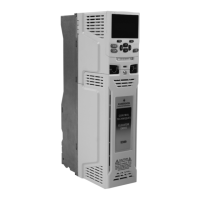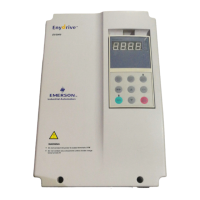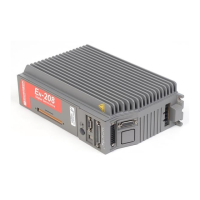Safety
information
Product
information
Mechanical
installation
Electrical
installation
Getting
started
User Menu A Commissioning
Advanced
Parameters
Diagnostics
Optimization CT MODBUS RTU Technical Data
476 E300 Design Guide
Issue Number: 1
10.4 Creep to floor - Start optimization
The start ride comfort of the Elevator can be optimized through either the profile settings or by adjustment of the drives control loop gains. The start
profile should firstly be set-up, optimized (Run jerk 1, and Acceleration rate) prior to adjustment of the drives control loop gains which include the Start
lock position gain plus speed and current control loop gains.
10.4.1 Profile settings
Optimization of the start profile is carried out adjusting the start S ramp (Run jerk 1) and the acceleration rate.
Table 10-2 Start profile optimization parameters
10.4.2 Control loop gains
During the start there is a start lock position control loop gain active during the brake control for optimization. Also during start there are both start
speed and current control loop gains and a start current loop filter. The position feedback filter available is active during the complete travel and if
required this should be adjusted to suit the start, travel and stop.
Table 10-3 Start control loop gains
10.5 Creep to floor - Travel optimization
The ride comfort of the Elevator can be optimized through either the profile settings or by adjustment of the drives control loop gains. The travel profile
should firstly be set-up, optimized (Run jerk 2, Operating speed V2 to V4) prior to adjustment of the drives speed and current control loop gains.
10.5.1 Profile settings
Optimization of the travel is carried out adjusting the end of acceleration S ramp (Run jerk 2) and the operating speeds V2 through to V4.
Table 10-4 Travel profile optimization parameters
10.5.2 Control loop gains
During the travel, there are both Run speed and current control loop gains available along with a current loop filter. The position feedback filter
available is active during the complete travel and if required this should be adjusted to suit the start, travel and stop.
Parameter Setting
Run Jerk 1 (G13)
The start S ramp can be increased if the Elevator starts with a jerk resulting in a slower more controlled start. If the
Elevator starts slowly and swings the start S ramp should be decreased resulting in an increased acceleration at
start.
Recommended = application specific
Acceleration Rate (G11)
The acceleration rate is set-up for the profile to reach a given acceleration for the rated speed with good ride
quality. This can be optimized to achieve higher levels of ride quality.
Recommended = application specific
Parameter Setting
Motor Torque Ramp Time (D02)
Time to ramp torque up on the motor against the mechanical brake, increase to overcome any acoustic
noise.
Start Lock P Gain Speed Clamp (I21)
The start lock position control loop P gain can be optimized if used following set-up of the speed and current
loop gains. Higher values of P gain will correct for any position error during brake release. Excessive values
will result in both instability while holding zero speed and acoustic noise.
Recommended = 10 to 100
Start Speed Loop P Gain (I01)
Start Speed Loop I Gain (I02)
Start speed loop gains are optimized to hold zero speed during brake release (I gain) and to provide smooth
control during the start P gain). Both gains can be limited where noise is present on the position feedback, in
this case the encoder feedback or current loop filter may be required.
Recommended P) = 800 to 2500
Recommended I) = 1000 to 3000
Start Current Loop P Gain (I03)
Start Current Loop I Gain (I04)
High values of current loop P gain (> 150 % of autotune value) can result in motor acoustic noise. Low
values of current control loop gains (< 50 % of autotune value) will result in oscillations and poor ride quality.
Recommended = Autotune values
Start Current Loop Filter (I05)
Used to over come motor acoustic noise and instability due to system induced noise as a result of un-
shielded cables or poor shield and ground terminations.
Recommended = 1.0 to 4.0 ms
Drive Encoder Feedback Filter (C09)
Used to over come motor acoustic noise and instability due to system induced noise as a result of un-
shielded cables or poor shield and ground terminations.
Recommended = 1 to 2 ms
Parameter Setting
Run Jerk 2 (G14)
If the ride comfort is hard at the end of acceleration when reaching constant speed increase the S ramp which will
result in a softer transition to the operating speed. If the ride comfort is soft decrease the S ramp which will provide a
stiffer transition through to the operating speed. Recommended = application specific
V2 Speed Reference (G02)
V3 Speed Reference (G03)
V4 Speed Reference (G04)
The operating speeds can be adjusted where the Elevator system is not reaching its required contract speed. The
selected operating speed can be seen in Reference Parameter Selected (J09). Recommended = application specific

